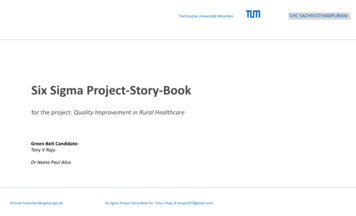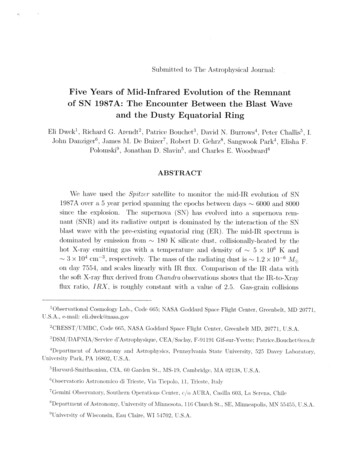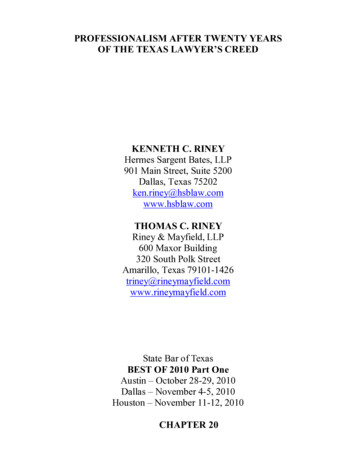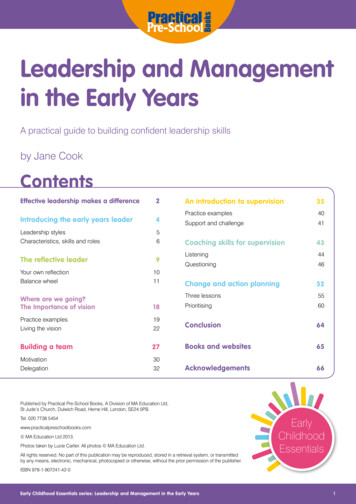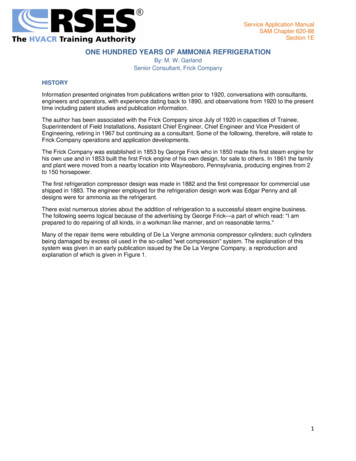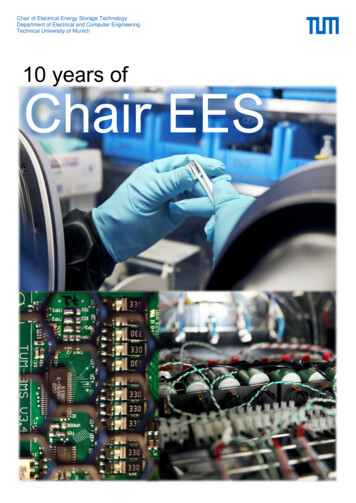
Transcription
Chair of Electrical Energy Storage TechnologyDepartment of Electrical and Computer EngineeringTechnical University of Munich10 years ofChair EES
Editing and Layout:Anupam ParlikarRobert PhillipsContact:Phone: 49 (0) 89 / 289-26967Fax: 49 (0) 89 / 289-26968Mail: sekretariat.ees@ei.tum.deWeb: www.ei.tum.de/eesPublisher:Technische Universität MünchenLehrstuhl für Elektrische EnergiespeichertechnikProf. Dr.-Ing. Andreas JossenArcisstr. 2180333 MünchenDeutschland2
Greetings from Professor JossenThe Chair of Electrical Energy Storage Technology (EES) wasfounded in May 2010 to strengthen research on electric vehiclesat TUM, with particular focus on battery engineering. In 2011 thechair became part of the Singaporean project TUM Create andparticipated in the development of the electric car “EVA”. In thecourse of the project we developed a 150 kW fast charging regime, which in only 15 minutes could provide enough charge for a200 km drive range. From 2013 onwards, in addition to batteriesfor electric vehicles, stationary energy storage systems and theirapplications in provision of ancillary services for grid stabilization,as well as behind-the-meter applications such as residential battery systems with photovoltaic solar have been part of our research portfolio.The research topics of the chair are related to cell and systemmodelling and simulation, measurement technologies for Li-ioncells, battery management, charging methods, battery lifetime andsafety investigations as well as topics related to the integration ofstationary energy storage systems in the electric grid.Over the last 10 years we have developed strong networks, notonly inside the Electrical and Computer Engineering Departmentand within the TUM as a whole, but also nationally and internationally, linking with such world leading research partners as theNTU and NUS in Singapore, Imperial College London, the NRELin the USA and Tsinghua University in Beijing. Inside the TUM weare both a member and a co-founder of the TUM.Battery network,as well as a member of the Munich School of Engineering. Wework closely with the departments of Mechanical Engineering,Chemistry and Physics. The majority of our funding is provided bythe Federal Ministry of Education and Research, the Federal Ministry for Economic Affairs and Energy, the state of Bavaria, theEuropean Union and industrial partners. Most projects are relatedto electric vehicles or stationary energy storage systems or can beplaced in a more general context of battery cell development.Prof. Dr.-Ing. Andreas JossenPhone: 49 (0) 89 / 289-26967Fax: 49 (0) 89 / 289-26968Email: andreas.jossen@tum.deAnother important task of the chair is the education of young engineers and scientists. The majority of both the students workingon their master theses and the research associates doing theirdoctoral theses will move on to work in the field of battery storagesystems, most typically in the automotive industry.In the years to come, we will see a strong increase in the numberof electric vehicles and the use of renewable energies worldwide.Our mission is to improve the efficiency, the performance, thesafety and the reliability of energy storage systems. We aim notonly to improve existing systems, but also to accelerate the development of these new technologies, and in doing so, achieve afaster transition to a more electric world.June 20203
The First 10 Years of the Chair EES2010Appointment of Professor Jossen as head of the Chair of Electrical Energy StorageTechnology (EES) at the Technical University of Munich (TUM).2011Start of TUM CREATE (Singapore), supervision of the research projects EnergyStorage Engineering & Energy Storage Systems.2012Management of the newly-founded Center of Excellence for Battery Cells at the TUM,ExZellTUM.2013Management of the new interdisciplinary research project EEBatt involving thirteenresearch groups at the TUM as well as industry partners.Demonstration of the electric taxi EVA developed by TUM CREATE at the TokyoMotor Show.2015Appointment of Professor Jossen as Editor of the journal “ MDPI Batteries”.Organization of the 1st International Battery Safety Workshop (IBSW).2016Founding of Li.plus GmbH, the first start-up spin off from the chair as part of the EXISTprogram of the German Federal Ministry for Economic Affairs and Energy.2017Establishment of an additional laboratory within the TUM Research Center for Energyand Information.Organization of the 2nd International Battery Safety Workshop (IBSW) in Albuquerque,New Mexico, USA.2018Founding of Battery Dynamics GmbH, a second spin-off of the chair.2019Founding of crino GmbH and m-Bee (now STABL) GmbH, both spin-offs from thechair and beneficiaries of the EXIST program.Formation of the TUM.Battery network with the EES as one of eight founding chairsat TUM.2020Co-coordination of the competence cluster "Battery Usage Concepts" as part of the"Battery Research Factory" framework of the German Federal Ministry of Educationand Research.Integration of the EES into the Department of Energy & Process Engineering at theTUM School of Engineering & Design.4
Facts & FiguresR&DProjects*Battery tations12426Master ThesesDiploma Theses26840Bachelor ThesesExaminations1729280Cumulative figures for the 10-yearperiod from 2010 – 2020.* with a cumulative funding ofroughly 13.5 m5
Research GroupsSimulationBatterySystemsBMSSESAdministration & Core FacilitiesResearch at EES is conductedwithinfourresearchgroupsfocusing on broad aspects ofbatteryresearch.Crucialcollaboration and support from theadministration, technical staff andlaboratory facilities enables cuttingedge research to take placesmoothly at the chair.Simulation (SIM)With spatially resolved and detailed physicochemical models, theelectrochemical, mechanical, and thermal properties of lithium-ionbatteries are investigated in order to understand, describe andoptimize the underlying mechanisms. The scope of modeling andsimulation typically includes experimental validation using varioustest setups.Battery Systems (SYS)The interdisciplinary team Battery Systems investigates allelectrical, thermal and mechanical issues, which arise during thedevelopment and operation of modern battery systems. The scopeof research covers the optimization of thermal managementsystems, safety behaviour, aging, cell-to-cell inhomogeneities,impact of mechanical stress and the design of cell connectors.Battery Management Systems (BMS)Battery management systems are an essential part of every largebattery pack. The team investigates batteries on the cell levelusing a large range of both established and novel characterizationmethods. The development of advanced algorithms for batterystate estimation and safety monitoring based on experimentalinsights is a central aim.Stationary Energy Storage Systems (SES)Multiple applications for stationary energy storage systems areemerging as we transition to renewable energies. The teamderives models of electrochemical and chemical energy storagesystems, and validates these with in-house experimental data andindustrial partners. Economically and ecologically optimal sizingand operation of storage units is discussed in a variety offramework conditions.6
Members of the ChairHead of the ChairProf. Dr.-Ing Andreas JossenDr.rer.nat. Holger HesseResearch ManagementDr.rer.nat. Gudrun Rahn-KoltermannAdministrative StaffCarolin NierwetbergAnne DiehlStefanie KäferTechnical StaffJens DietrichKorbinian SchmidtDaniel KucevicAlexander KunzSebastian LudwigMarc MöllerErfan Moyassari SardahaeiAndreas NoelAndreas OberbauerAnupam ParlikarThomas RothMaximilian SchellerMarkus SchindlerJulius SchmittJonas SoellnerFranz SpinglerMarco SteinhardtLuiza StreckJohannes SturmBenedikt TepeYulong ZhaoIlya ZilbermannResearch StaffAndreas AufschlägerFelix BauerNils CollathAxel DurdelStefan EnglbergerAlexander FrankSven FriedrichElisabeth GillichThomas HeilPhilipp JocherLudwig Kraft7
8
Research ActivitiesExperimental research activities are conducted in laboratories.operated by the EES and by partner institutes. The laboratoriesare located at three locations – at the main EES premises(Karlstr. 45 in Munich, Germany), at the TUM main campus (Arcisstr. 21 in Munich, Germany), and at the Research Centre forEnergy and Information (Lichtenbergstr. 4a in Garching, Germany). The four research groups at EES engage in highly collaborative research across the entire chain in battery research.Research associates at theResearch Centre for Energyand Information.Electrochemical ImpedanceSpectroscopy (EIS) measurements being carried out withina temperature-controlled environment.9
Modeling, Simulation and ValidationMechanical Aspects of Battery PerformanceSchematic of 2D Laser-Scanning setup for the measurement of local cell expansion during operation (left) and local expansion overshoot of a pouch cell during high-current charging (right).ResearchersMechanical Characterization from Particle to Cell LevelAndreas AufschlägerSven FriedrichErfan MoyassariMaximilian SchellerFranz SpinglerJohannes SturmIntercalation electrodes used in lithium-ion cells expand and contract upon charging and discharging. This creates mechanicalstress as cells are confined by their individual cell casings, andtypically embedded in modules. Depending on the electrode material, the magnitude of the reversible volume change varies considerably.PublicationsY. Zhao, F. Spingler et al., LocalizedSwelling Inhomogeneity Detectionin Lithium-Ion Cells Using Multi-Dimensional Laser Scanning, J. Electrochem. Soc., 2019.F. Spingler et al., Optimum FastCharging of Lithium-Ion Pouch CellsBased on Local Volume ExpansionCriteria, J. of Power Sources, 2018.J. Sturm et al., Non-Destructive Detection of Local Aging in Lithium-IonPouch Cells by Multi-Directional Laser Scanning, J. Electrochem. Soc.,2017.B. Rieger et al., A New Method toModel the Thickness Change of aCommercial Pouch Cell during Discharge, J. Electrochem. Soc., 2016.B. Rieger et al., Strain Propagationin Lithium-Ion Batteries from theCrystal Structure to the ElectrodeLevel, J. Electrochem. Soc., 2016.10One important objective is to understand the implications of electrode volume change and mechanical stress on the performance,safety and lifetime of batteries.Characterization of the mechanical behavior at particle, electrodeand cell level is carried out. This is done via in-situ X-ray diffraction(for particles), in-situ precision dilatometry (for electrodes) andvarious cell-level test setups which have been developed inhouse, such as a 2D laser scanner to measure local cell expansion and various test benches that control cell expansion whilemeasuring the resulting loads.Modeling of Mechanical-Electrochemical InteractionsWe also use coupled physicochemical-mechanical models to understand how cell expansion and external loads affect local current densities, overpotentials, material strain and stress, deterioration processes and the lifetime of lithium-ion batteries.
Modeling, Simulation and ValidationExternal and Local Short-Circuit Scenarios in Lithium-Ion BatteriesTest-bench (left) for applying external and local short-circuit scenarios to lithium-ion batteries. Measurement of currentflux, tab voltage, and heat generation (center) facilitate correlation between external and local short-circuits (right).Applying External and Local Short-Circuit ConditionsResearchersEmulating true, field-like internal short-circuits (ISCs) with experimental methods is a complex task with mostly unsatisfactory outcomes. However, understanding the evolution and impact of ISCsis crucial to mitigate safety issues related to lithium-ion batteries.Local short-circuit (LSC) conditions can be applied to pouch-typecells in a quasi-isothermal test-bench using the nail/needle penetration approach. Cell impedance, capacity, and the contact resistance at the penetration site are the main determinants ofshort-circuit current. This in turn largely determines the terminalvoltage and heat generation rate associated with polarization effects and electrochemical rate limitations. It has been shown byboth potentiostatic and calorimetric measurements that similarshort-circuit behavior can be induced by external short-circuits(ESCs) at various short-circuit resistances.As a result, local short-circuits caused by the needle penetrationcan be emulated by an ESC test with an appropriately chosenexternal resistance.Johannes SturmSven FriedrichErfan MoyassariThomas RothAlexander Rheinfeld*Modeling and Simulation of Short-Circuit ScenariosInsights into the local potential distribution across the electrodeshelp to evaluate the measured electrical potentials of an externally and locally triggered shorting scenario. With the aid of multidimensional, multi-physics models, the resulting local polarization effects across the electrodes can be simulated and the shortcircuit intensity can be correlated.PublicationsA. Rheinfeld et al., Quasi-IsothermalExternal Short-Circuit Tests Appliedto Lithium-Ion Cells: Part I. Measurements, J. Electrochem. Soc., 2018.A. Rheinfeld et al., Quasi-IsothermalExternal Short-Circuit Tests Appliedto Lithium-Ion Cells: Part II. Modeling and Simulation, J. Electrochem.Soc., 2019.J. Sturm et al, On the Impact of theLocality on Short-Circuit Characteristics: Experimental Analysis andMulti-physics Simulation of Externaland Local Short-Circuits Applied toLithium-Ion Batteries, J. Electrochem. Soc., 2020.* Researchers graduated in 2019, and do not currently work at the Chair.11
Modeling, Simulation and ValidationAging Phenomena in Lithium-Ion BatteriesResults of an aging study applied to commercial, 18650-type C/NMC-111 lithium-ion cells reveal linear and non-linearaging capacity fade mechanisms (left), shifts and shrinkages in the differential voltage analysis curve (DVA, center), andcorrelation between capacity fade determination using potentiostatic methods (‘Electrochemica
Organization of the 2nd International Battery Safety Workshop (IBSW) in Albuquerque, New Mexico, USA. 2018 Founding of Battery Dynamics GmbH, a second spin-off of the chair. 2019 Founding of crino GmbH and m-Bee (now STABL) GmbH, both spin-offs from the chair and beneficiaries of the EXIST program. Formation of the TUM.Battery network with the EES as one of eight founding chairs at TUM.

